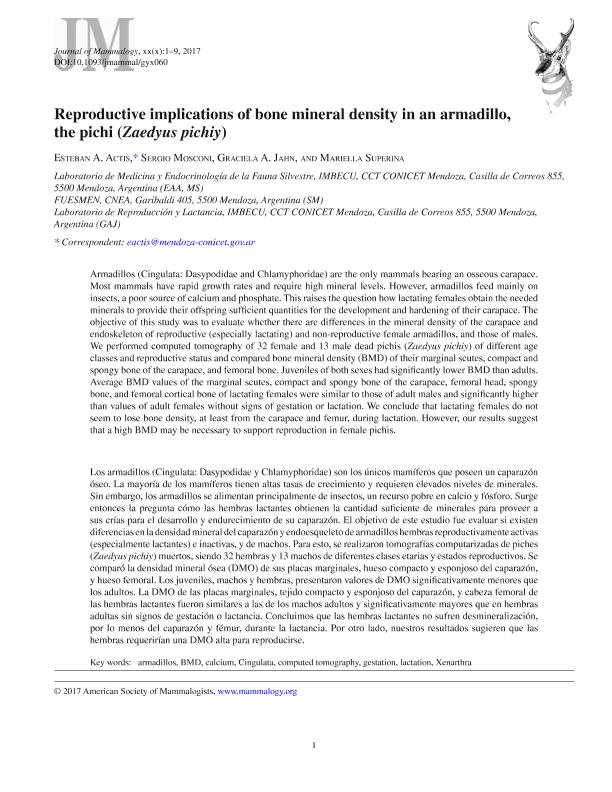Artículo
Armadillos (Cingulata: Dasypodidae and Chlamyphoridae) are the only mammals bearing an osseous carapace. Most mammals have rapid growth rates and require high mineral levels. However, armadillos feed mainly on insects, a poor source of calcium and phosphate. This raises the question how lactating females obtain the needed minerals to provide their offspring sufficient quantities for the development and hardening of their carapace. The objective of this study was to evaluate whether there are differences in the mineral density of the carapace and endoskeleton of reproductive (especially lactating) and non-reproductive female armadillos, and those of males. We performed computed tomography of 32 female and 13 male dead pichis (Zaedyus pichiy) of different age classes and reproductive status and compared bone mineral density (BMD) of their marginal scutes, compact and spongy bone of the carapace, and femoral bone. Juveniles of both sexes had significantly lower BMD than adults. Average BMD values of the marginal scutes, compact and spongy bone of the carapace, femoral head, spongy bone, and femoral cortical bone of lactating females were similar to those of adult males and significantly higher than values of adult females without signs of gestation or lactation. We conclude that lactating females do not seem to lose bone density, at least from the carapace and femur, during lactation. However, our results suggest that a high BMD may be necessary to support reproduction in female pichis. Los armadillos (Cingulata: Dasypodidae y Chlamyphoridae) son los únicos mamíferos que poseen un caparazón óseo. La mayoría de los mamíferos tienen altas tasas de crecimiento y requieren elevados niveles de minerales. Sin embargo, los armadillos se alimentan principalmente de insectos, un recurso pobre en calcio y fósforo. Surge entonces la pregunta cómo las hembras lactantes obtienen la cantidad suficiente de minerales para proveer a sus crías para el desarrollo y endurecimiento de su caparazón. El objetivo de este estudio fue evaluar si existen diferencias en la densidad mineral del caparazón y endoesqueleto de armadillos hembras reproductivamente activas (especialmente lactantes) e inactivas, y de machos. Para esto, se realizaron tomografías computarizadas de piches (Zaedyus pichiy) muertos, siendo 32 hembras y 13 machos de diferentes clases etarias y estados reproductivos. Se comparó la densidad mineral ósea (DMO) de sus placas marginales, hueso compacto y esponjoso del caparazón, y hueso femoral. Los juveniles, machos y hembras, presentaron valores de DMO significativamente menores que los adultos. La DMO de las placas marginales, tejido compacto y esponjoso del caparazón, y cabeza femoral de las hembras lactantes fueron similares a las de los machos adultos y significativamente mayores que en hembras adultas sin signos de gestación o lactancia. Concluimos que las hembras lactantes no sufren desmineralización, por lo menos del caparazón y fémur, durante la lactancia. Por otro lado, nuestros resultados sugieren que las hembras requerirían una DMO alta para reproducirse. Armadillos (Cingulata: Dasypodidae and Chlamyphoridae) are the only mammals bearing an osseous carapace. Most mammals have rapid growth rates and require high mineral levels. However, armadillos feed mainly on insects, a poor source of calcium and phosphate. This raises the question how lactating females obtain the needed minerals to provide their offspring sufficient quantities for the development and hardening of their carapace. The objective of this study was to evaluate whether there are differences in the mineral density of the carapace and endoskeleton of reproductive (especially lactating) and non-reproductive female armadillos, and those of males. We performed computed tomography of 32 female and 13 male dead pichis (Zaedyus pichiy) of different age classes and reproductive status and compared bone mineral density (BMD) of their marginal scutes, compact and spongy bone of the carapace, and femoral bone. Juveniles of both sexes had significantly lower BMD than adults. Average BMD values of the marginal scutes, compact and spongy bone of the carapace, femoral head, spongy bone, and femoral cortical bone of lactating females were similar to those of adult males and significantly higher than values of adult females without signs of gestation or lactation. We conclude that lactating females do not seem to lose bone density, at least from the carapace and femur, during lactation. However, our results suggest that a high BMD may be necessary to support reproduction in female pichis.
Reproductive implications of bone mineral density in an armadillo, the pichi (Zaedyus pichiy)
Fecha de publicación:
10/2017
Editorial:
Oxford University Press
Revista:
Journal of Mammalogy
ISSN:
0022-2372
Idioma:
Inglés
Tipo de recurso:
Artículo publicado
Clasificación temática:
Resumen
Palabras clave:
Armadillos
,
Bmd
,
Calcium
,
Cingulata
,
Computed Tomography
,
Gestation
,
Lactation
,
Xenarthra
Archivos asociados
Licencia
Identificadores
Colecciones
Articulos(IMBECU)
Articulos de INST. DE MEDICINA Y BIO. EXP. DE CUYO
Articulos de INST. DE MEDICINA Y BIO. EXP. DE CUYO
Citación
Actis Peña, Esteban Alberto; Mosconi, Sergio; Jahn, Graciela Alma; Superina, Mariella; Reproductive implications of bone mineral density in an armadillo, the pichi (Zaedyus pichiy); Oxford University Press; Journal of Mammalogy; 98; 5; 10-2017; 1400-1407
Compartir
Altmétricas




